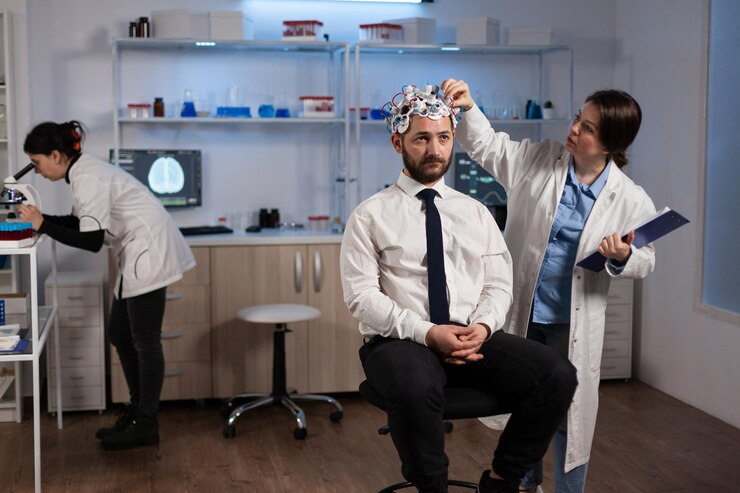Migraines are debilitating headaches that can steal your day and leave you in a fog. If you’re one of the millions of people who suffer from migraines, you know all too well the intense pain, nausea, and sensitivity to light and sound that can accompany an attack. But you don’t have to live in fear of the next migraine. This guide will equip you with the knowledge to find relief, explore medication options, and ultimately conquer your migraines.
Migraine study
A new study published in Neurology shed light on the effectiveness of various migraine medications. The research, based on self-reported data from a large app-based survey of over 278,000 people (mostly women), tracked participants’ experiences with migraine medication over six years. Participants rated the effectiveness of their migraine medication as “helpful,” “somewhat helpful,” or “unhelpful.” Researchers analyzed 25 medications across seven drug classes to determine which were most successful in alleviating migraines. Triptans emerged as the most helpful class of migraine medication, followed by ergots (including dihydroergotamine) and antiemetics (like promethazine), which help manage nausea, another frequent migraine symptom.
Study about migraine pain relievers
While ibuprofen, a common pain reliever (sold as Advil and Motrin), was the most used medication in this study, participants only rated it helpful about 42% of the time. Acetaminophen (Tylenol) fared even worse, with just 37% reporting it effective. A combination drug like Excedrin (containing aspirin, acetaminophen, and caffeine) only offered slightly better relief than ibuprofen, coming in at around 50% helpful. The search for the best migraine medicine continues! The study found triptans to be significantly more useful than ibuprofen, scoring five to six times higher. Eletriptan, the top-ranked drug, provided relief for 78% of users. Other triptans like zolmitriptan (Zomig) and sumatriptan (Imitrex) were close behind at 74% and 72% helpful rates, respectively. While Dr. Loder notes that eletriptan might have a slight edge, they all appear to be far more effective migraine medications than ibuprofen. Ergots were rated three times more helpful than ibuprofen, and antiemetics came in at two and a half times more effective.

Do people take more than one medicine to ease migraines?
The study revealed that most migraine treatments involved just one medication—two-thirds of attacks were treated this way. Around a quarter of participants used two drugs, and a smaller group relied on three or more. It’s important to note that researchers couldn’t determine the exact order in which people took these medications. Dr. Loder also highlights that for anti-nausea medications, it’s unclear if participants rated their effectiveness on nausea relief or headache reduction specifically. However, the study does underscore a significant point: nausea and vomiting are very common problems for many migraine sufferers. In these cases, using different drug formulations can be particularly helpful in managing both migraine and neck pain, which often go hand-in-hand.

Are pills the only option for migraine relief?
When it comes to treating the headache itself, some migraine sufferers can opt for a faster-acting alternative to pills. Triptans come in nasal spray and injectable forms, offering relief quicker than traditional tablets. For those experiencing very rapid-onset migraines, Dr. Loder emphasizes the underutilized option of pre-filled syringes injected into the thigh, stomach, or upper arm. “These injectable triptans are a game changer for people whose migraines come on very quickly because pills can be too slow and might not stay down,” she explains. While nausea can be a significant issue during a migraine, it’s important to consider all the side effects of medications. Ondansetron (Zofran), a common antiemetic, can worsen headaches. Dr. Loder recommends promethazine or prochlorperazine (Compazine) as superior options. These medications not only manage nausea but also contribute to headache relief.
Furthermore, many anti-nausea medications come in suppository form, which can be particularly helpful for those experiencing “crash” migraines—migraines that cause vomiting upon waking. In these cases, suppositories offer relief without the need for swallowing, which can be difficult during a migraine attack. For additional migraine management strategies, consider consulting with your doctor about the potential benefits of migraine glasses.
You might like this:
Limitations of this migraine study
While the study provided valuable insights, it also had limitations. Data on medication timing, sequence, specific formulations (tablets, sprays, etc.), and dosage weren’t available. Additionally, two newer migraine medication classes, gepants and ditans, were excluded due to limited data at the time of the study. These newer options include medications like atonement (Qulipta) and rimegepant (Nurtec) for gepants and lasmiditan (Reyvow) for ditans. “In my clinical experience, it’s unlikely these newer drugs would significantly outperform triptans,” says Dr. Loder. Another factor to consider is the study population itself. Participants were app users who were likely motivated and able to track their migraines on a smartphone app. This suggests their migraines may be more severe than the average sufferer, but this exact population can benefit most from this information. ‘Migraines are most common in young, healthy adults who often juggle work and family life,” says Dr. Loder. The fact that app users rated Triptans highly is positive news because, from a medical perspective, these medications are generally well-tolerated with minimal side effects. This is especially important when comparing them to over-the-counter pain relievers like Excedrin Migraine, which can have more frequent side effects.
Solutions for migraine
Acute pain relief:
Triptans: As the study mentioned, triptans are a highly effective class of medication specifically designed for migraines. They come in various forms, like tablets, nasal sprays, and injections, offering relief tailored to your needs.
Pain relievers: Over-the-counter pain relievers like ibuprofen or acetaminophen can sometimes help with mild migraines. However, the study showed they were less effective than triptans. Important note: consult your doctor before using these medications regularly, especially if you have other health conditions.
Anti-nausea medication: Nausea is a common migraine symptom. Medications like promethazine or prochlorperazine can help manage nausea and even contribute to headache relief.
Preventive measures:
Identify and avoid triggers: Common triggers include stress, lack of sleep, certain foods and drinks, and hormonal changes. Keeping a migraine diary can help you identify your triggers and avoid them.
Maintain a healthy lifestyle.
- Getting enough sleep.
- Eating a balanced diet.
- Exercising regularly can help reduce migraine frequency and intensity.
Relaxation techniques: Stress management techniques like meditation, yoga, and deep breathing can help prevent migraines and ease symptoms during an attack.
Consider migraine glasses. Migraine glasses have tinted lenses that can help filter out bright light and reduce visual disturbances, a common migraine trigger. While not a cure, they can offer some relief during an attack.

Additional tips:
Stay hydrated: Dehydration can worsen headaches, so drink fluids throughout the day.
Create a migraine-friendly environment. Find a quiet, dark room and rest during an attack. Apply a cool compress to your forehead or neck for additional relief.
Talk to your doctor. If over-the-counter medications aren’t effective or your migraines are significantly impacting your life, discuss preventive medications and other treatment options with your doctor.
Remember, everyone experiences migraines differently. What works for one person might not work for another. It’s important to find a combination of solutions that help manage your migraines and improve your quality of life.



